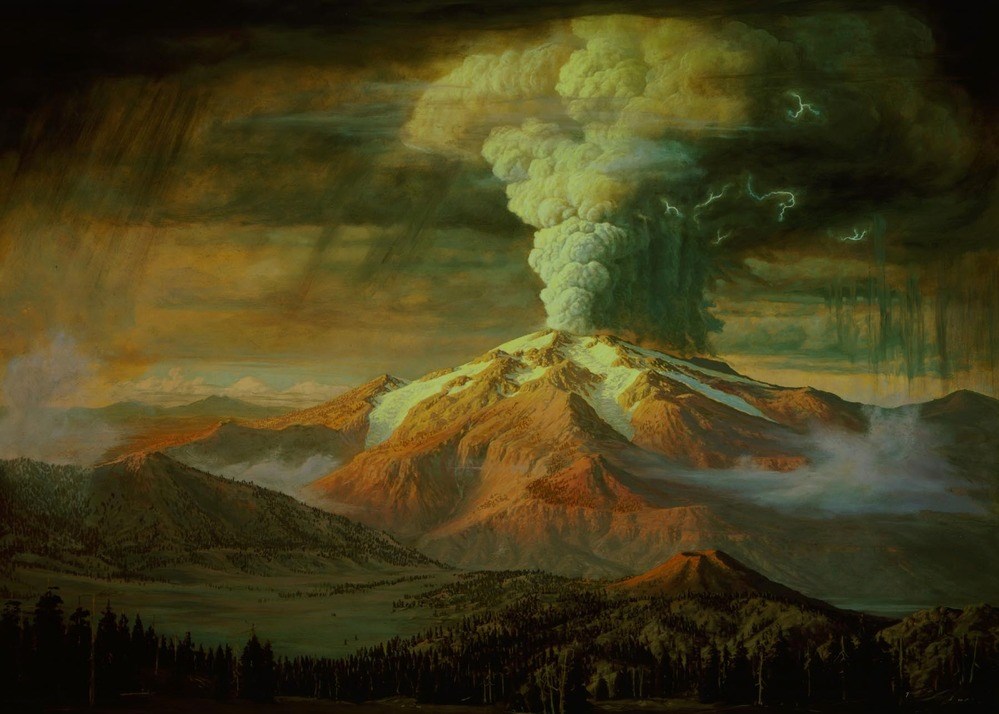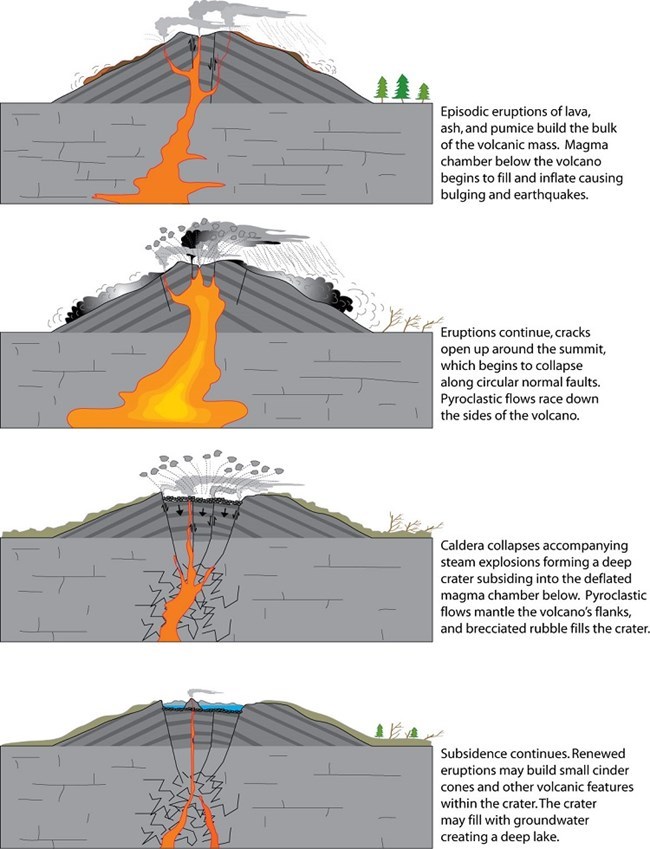Part of a series of articles titled Volcano Types.
Previous: Calderas
Next: Summit Calderas
Article

NPS image of a Paul Rockwood painting.
Calderas form when magma chambers are partially emptied during large eruptions and the land surface subsides and the area above the shallow magma reservoir collapses. Explosive calderas form during especially large Plinian and Ultra-Plinian eruptions that send ash columns high into the stratosphere and create large-volume pyroclastic flows.

Caldera-forming eruptions are truly massive, and are orders of magnitude larger than the 1980 eruption of Mount St. Helens. The St. Helens eruption had a magnitude of 5 on the Volcanic Explosivity Index (VEI), a scale of 0 to 8 that describes the size of explosive volcanic eruptions based on magnitude and intensity. The VEI is a logarithmic scale meaning that each interval represents a ten-fold increase in the size of an eruption. The explosive eruptions that accompany caldera collapse range from 6 to 8 on the VEI. VEI 8 eruptions are super eruptions such as the ones that occurred at Yellowstone 2.1 and 0.64 million years ago.
The eruption sequence for a summit caldera, modeled after the Mount Mazama eruption 7,700 years ago that formed Crater Lake in Crater Lake National Park.
Graphic by Trista L. Thornberry-Ehrlich, Colorado State University.
Explosive calderas erupt silicic (dacite to high silica rhyolite) magmas from reservoirs that may be compositionally-zoned.
Summit calderas form on preexisting composite volcanoes that experience VEI 6-7 eruptions that cause their summits to collapse. Summit calderas may become filled with precipitation to form steady-state lakes, although these lakes may also be drained if the caldera rim becomes breached.
Aniakchak National Monument, Alaska
Crater Lake National Park, Oregon
Katmai National Park (Mount Katmai), Alaska
Resurgent calderas are substantially larger than summit calderas and have diameters of many tens of miles (kms). Although they form in areas that have previously experienced volcanism, they do not form on any preexisting volcanic edifice. VEI 7-8 eruptions lead to caldera formation.
Valles Caldera National Preserve, New Mexico
Yellowstone National Park, Idaho, Montana, and Wyoming
The presence of large-volume ash-flow tuffs (ignimbrites) are one of the main markers for the presence of older caldera complexes. Subsequent erosion and/or volcanic activity can make their caldera walls hard to find. Most of the older caldera complexes in or near national park sites are very large and were of the resurgent type.
Big Bend National Park, Texas
Chiricahua National Monument, Arizona
Coronado National Memorial, Arizona
Gila Cliff Dwellings National Monument, New Mexico
Saguaro National Park, Arizona
Aniakchak National Monument (ANIA), Alaska—[ANIA Geodiversity Atlas] [ANIA Park Home] [ANIA npshistory.com]
Bandelier National Monument (BAND), New Mexico—[BAND Geodiversity Atlas] [BAND Park Home] [BAND npshistory.com]
Big Bend National Park (BIBE), Texas—[BIBE Geodiversity Atlas] [BIBE Park Home] [BIBE npshistory.com]
Chiricahua National Monument (CHIR), Arizona—[CHIR Geodiversity Atlas] [CHIR Park Home] [CHIR npshistory.com]
Coronado National Monument (CORO), Arizona—[CORO Geodiversity Atlas] [CORO Park Home] [CORO npshistory.com]
Crater Lake National Park (CRLA), Oregon—[CRLA Geodiversity Atlas] [CRLA Park Home] [CRLA npshistory.com]
Gila Cliff Dwellings National Monument (GICL), New Mexico—[GICL Geodiversity Atlas] [GICL Park Home] [GICL npshistory.com]
Katmai National Park (KATM), Alaska—[KATM Geodiversity Atlas] [KATM Park Home] [KATM npshistory.com]
Saguaro National Park (SAGU), Arizona—[SAGU Geodiversity Atlas] [SAGU Park Home] [SAGU npshistory.com]
Valles Caldera National Preserve (VALL), New Mexico—[VALL Geodiversity Atlas] [VALL Park Home] [VALL npshistory.com]
Yellowstone National Park (YELL), Wyoming—[YELL Geodiversity Atlas] [YELL Park Home] [YELL npshistory.com]
Part of a series of articles titled Volcano Types.
Previous: Calderas
Next: Summit Calderas
Last updated: April 17, 2023